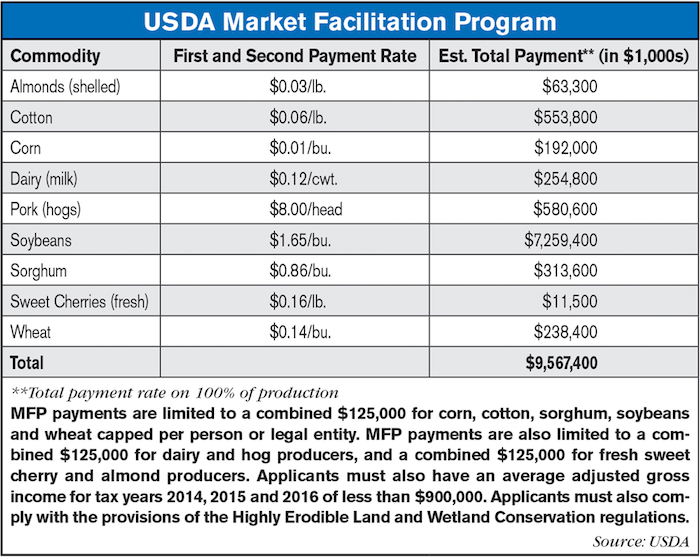Earlier this week USDA announced that it was launching the second round of Trade Mitigation Payments aimed at assisting farmers suffering from damage due to unjustified trade retaliation by foreign nations. According to the ag agency, producers of certain commodities will now be eligible to receive Market Facilitation Program (MFP) payments for the second half of their 2018 production.
As announced in July, USDA would make $9.6 billion available to farmers who were monetarily damaged by unjustified retaliation by other countries that implemented unfair tariffs on agricultural products. About half of the available funds were paid out in September to almond, corn, cotton, dairy, hog, sorghum, soybean, fresh sweet cherry and wheat producers. The second half of the promised funds will now be distributed to eligible producers.
While the MFP payments were welcome relief to many producers, others believe the way the payment rates were calculated.
The American Soybean Assn. expressed its appreciation for the payments. In its official response to the announcement said, “Soy growers are very thankful that President Trump understands the need for this payment on the full 2018 production and that the Administration will deliver the second half of the aid as promised. While it will not make our losses whole, it will certainly help offset the drop in prices we have experienced since China cut off U.S. soybean imports,” said ASA president Davie Stephens, a soybean producer from Clinton, Ky. “We saw some initial sales of U.S. soybeans to China last week, which was also welcomed news and we hope a sign that the trade war could be turning a corner as a result of President Trump’s recent meeting with President Xi.”
The National Corn Growers Assn., on the other hand, expressed its disappointment with the announcement. They believe the payments to corn producers are woefully inadequate because of the way the payment rate for corn calls is only one cent per bushel. According to NCGA, corn farmers have suffered an average 44 cent per bushel loss since tariffs were first announced.
“Farmers of all crops have felt the impact of trade tariffs,” said NCGA President Lynn Chrisp. “NCGA appreciates the progress the administration has made to advance ethanol, reach a new agreement with Mexico and Canada and move forward on negotiations with Japan, but the benefits of these efforts will take time to materialize and farmers are hurting now.
“One cent per bushel is woefully inadequate to even begin to cover the losses being felt by corn farmers. USDA did not take into account the reality that many of our farmers are facing,” Chrisp added.
NCGA said it had called on USDA to add ethanol and distillers dried grains with solubles (DDGS) to the calculation of damages for corn, roughly $254 million. The organization also asked that farmers who suffered production losses from disasters be allowed to use an alternative to 2018 production for their MFP calculation, ensuring those suffering losses from natural disasters would not be penalized twice. These requests were repeated in subsequent conversations between NCGA and administration officials but ultimately ignored in USDA’s final payment calculation for round two, according to the association.
Calculation of the payments for the Market Facilitation Program is as follows:




![[Technology Corner] What are the Top 5 Applications in Autonomy Right Now?](https://www.agequipmentintelligence.com/ext/resources/2024/11/08/What-are-the-Top-5-Applications-in-Autonomy-Right-Now-.png?height=290&t=1731094940&width=400)
Post a comment
Report Abusive Comment